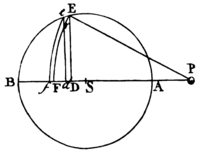evaneſcent line Dd to the evaneſcent line Ff is the ſame as that of the line PE to the line PS.
For if the line Pe cut the arc EF in q; and the right line Ee, which coincides with the evaneſcent arc Ee, be produced and meet the right line PS in T; and there be let fall from S to PE the perpendicular SG; then becauſe of the like triangles DTE, dTe, DES; it will be as Dd to Ee ſo DT to TE, or DE to ES; and becauſe the triangles Eeq, ESG (by lem. 8. and cor. 3. lem. 7.) are ſimilar, it will be as Ee to eq or Ff ſo ES to SG; and ex æquo, as Dd to Ff ſo DE to SG; that is (becauſe is the ſimilar triangles PDE, PGS) ſo is PE to PS. Q. E. D.
Proposition LXXIX. Theorem XXXIX.

Supoſſe a ſuperficies as EFfe (Pl. 22 Fig. 5.) to have its breadth infinitely diminished, and to be juſt vaniſhing; and that the ſame ſuperficies by its revolution round the axis PS deſcribes a ſphærical concavo-convex ſolid to the ſeveral equal particles of which there tend equal centripetal forces; I ſay that the force with which that ſolid attracts a corpuſcle ſituate in P, is in a ratio compunded of the ratio of the ſolid and the ratio of the force with

